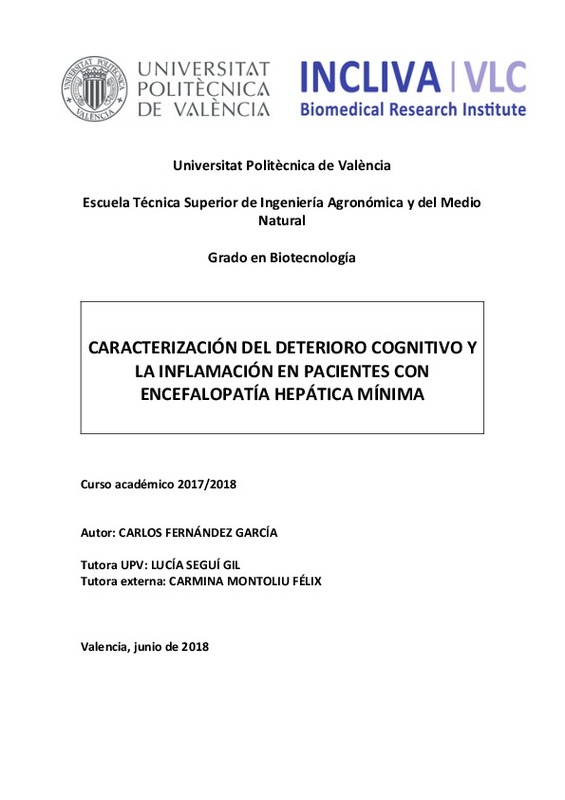|
Resumen:
|
[EN] Hepatic encephalopathy (HE) is a neuropsychiatric syndrome characterize by a series of neurological disorders resulting from liver failure, such as cirrhosis. Minimal hepatic encephalopathy(MHE)represents the initial ...[+]
[EN] Hepatic encephalopathy (HE) is a neuropsychiatric syndrome characterize by a series of neurological disorders resulting from liver failure, such as cirrhosis. Minimal hepatic encephalopathy(MHE)represents the initial stage of this disease and is characterized by mild and subtle cognitive impairment that worsens the quality of life of patients. The EHM is diagnosed by the test called PHES. This test consists of a battery of 5 subtests, each of which evaluates a different cognitive aspect, !if the result of this test is D4 or less, the patient is considered to have MHE. However, some patients classified as having no MHE due to PHES show some cognitive impairment; this group of patients is called "borderDline".There is another type of test that evaluates cognitive and motor skills focused on characterizing this cognitive impairment. On the other hand, the concentration of ammonium and the levels of interleukins ILD6 andLD18 in blood have been measured, because a correlation has been found between the levels of Hyperammonemia and inflammation with cognitive deficit. This study aims to demonstrate that the PHES is not sensitive enough for the early diagnosis of cognitive deterioration while others are, to prove the existence of a borderline group and to Relate the levels of ammonium and cytokines with cognitive impairment. The results obtained in the different tests show that the PHES does not detect the presence of borderline patients, while with!other tests they are identified and differentiated from patients without MHE.These results!are corroborated by the concentration of The interleukins, since Both patients with MHE and borderline have a higher interleukin concentration compared to Subjects without MHE. Regarding ammonium,no significant variations were observed between different patients.
[-]
[ES] La encefalopatía hepática (EH) es un síndrome neuropsiquiátrico que se caracteriza por una serie de trastornos neurológicos resultantes de una insuficiencia hepática, como es la cirrosis. La encefalopatía hepática ...[+]
[ES] La encefalopatía hepática (EH) es un síndrome neuropsiquiátrico que se caracteriza por una serie de trastornos neurológicos resultantes de una insuficiencia hepática, como es la cirrosis. La encefalopatía hepática mínima (EHM) representa el estadio inicial de esta enfermedad y se caracteriza por presentar un deterioro cognitivo (CI) leve y sutil que empeora la calidad de vida de los pacientes. El 33-50% de los pacientes cirróticos sin síntomas evidentes de EH presentan EHM.
Un gran porcentaje de pacientes con encefalopatía hepática mínima tienen enlentecimiento psicomotor, déficits cognitivos leves y concentración e incoordinación motora que disminuyen su calidad de vida y aumentan el riesgo de padecer accidentes. También incluye trastornos de los ciclos de sueño-vigilia (ritmos circadianos), etc... Los mecanismos que conducen a estas alteraciones no se conocen bien y no existen tratamientos específicos para revertirlas. Por tanto, una caracterización más detallada de las alteraciones neurológicas más tempranas en EHM permitiría estudiar mejor los mecanismos implicados y diseñar y ensayar nuevos tratamientos.
El objetivo principal del presente estudio consistirá en probar que la batería del PHES no es suficientemente sensible para detectar déficit cognitivo en los estadios iniciales, y por esta razón, se requerirá introducir una serie de tests más específicos y enfocados a este tipo de pacientes. También se pretenderá demostrar que existe una proporción de pacientes cirróticos, a los que se les atribuye el nombre de border-line , que ya manifiestan déficits neurológicos a pesar de ser clasificados como sin EHM por el PHES.
Un objetivo secundario, sería establecer una relación entre hiperamonemia y los niveles de interleuquinas, con la alteración cognitiva con el fin de caracterizar la inflamación en los pacientes cirróticos con EHM.
Se considera como procedimiento de referencia para la detección de EHM la realización de una batería de 5 test psicométricos denominada PHES (Psychometric Hepatic Encephalopathy Score). Para la determinación neuropsicológicos los pacientes realizaron además del PHES, diferentes tipos de tests: Stroop, D2, Claves orales, Test oral de dígitos, Coordinación bimanual y visuo-motora, test de memoria, Wisconsin, Vienna y Cantab.
También se determinaron los parámetros bioquímicos, tales como el amonio en sangre empleando el Ammonia Checker II, dispositivo basado en el método de microdifusión que cuantifica los niveles de amonio en sangre empleando un reactivo a partir de una muestra de sangre. Otros parámetros bioquímicos cuantificados fueron los niveles de IL-6, IL-18 y GMP cíclico como marcadores de inflamación. Estos parámetros se calcularon mediante el método ELISA.
A partir de los resultados de los test, se utilizarán diversos programas estadísticos para buscar relaciones entre ellos y poder determinar si un test es más o menos eficaz a la hora de diagnosticar la EHM. Se usará el Graphpad Prism 6.0 para representar los distintos datos en gráficas y el SPSS 9.0 para buscar correlaciones.
[-]
|







